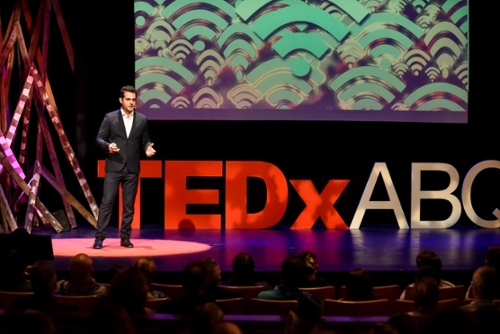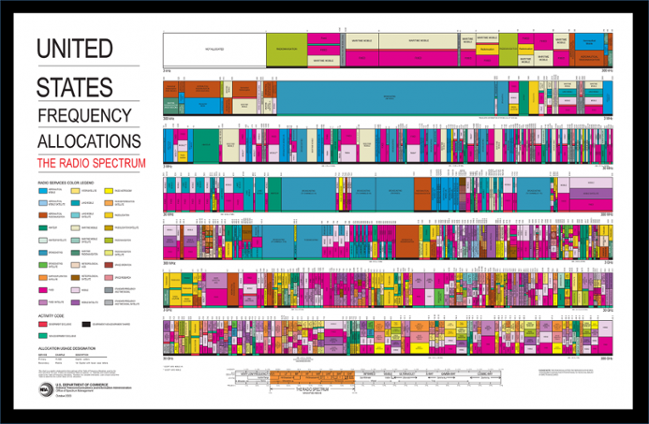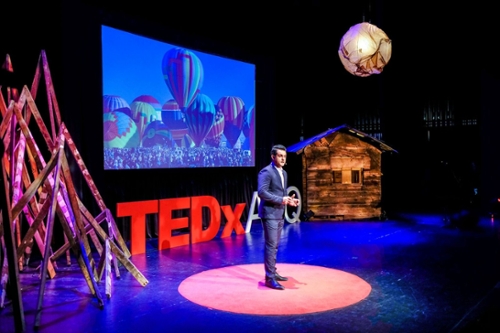Recent News
CHTM Joins NSF's NQVL Pilot Projects
August 9, 2024
OSE PHD, Dr. Xuefeng Li - Wins The Outstanding Interdisciplinary Graduate Programs Award
May 10, 2024
Dr. Ali Rastegari - 2024 OSE Best Dissertation Award Winner
May 10, 2024
2024 OSE Spring and Summer Graduates
May 10, 2024
News Archives
Arman Rashidi Highlights His Research and CHTM as TEDxABQ Speaker
October 31, 2018 - CHTM

TEDxABQ hosted its ninth annual main event in September at the National Hispanic Cultural Center featuring 13 speakers. Over 100 people applied to speak this year and CHTM's own, Arman Rashidi, was among the selected 13.
Arman Rashidi is a PhD graduate student at the Center for High Technology Materials, working with Dr. Daniel Feezell's group. His research is to develop high-speed LEDs for visible-light communication (VLC) applications. LiFi, the subject of his TEDxABQ talk, is one of the applications of VLC. At CHTM, we have received a world record modulation bandwidth of 1.5 GHz for our LEDs. "We are known for this fields of research, in the world," stated Rashidi. Conventional Gallium Nitride (GaN) LEDs are developed on polar GaN which causes quantum confined stark effect (QCSE) in the quantum well of the LEDs which reduces their modulation bandwidth. Here, at CHTM, we use nonpolar GaN instead, to develop LEDs which enabled the 1.5GHz modulation bandwidth. It was the first time that this was done to create high-speed LEds. The only problem with nonpolar materials, is that they are more expensive compared to the conventional polar GaN substrates. However, they're hopeful that the materials will become cheaper over time and after some development by the substrate industry.
His talk, entitled, "LiFi: The future Internet from every light bulb," was about the congestion of the radio frequency spectrum adn the danger of "spectrum crunch." What is spectrum crunch, you may ask? Spectrum crunch refers to the potential lack of sufficient wireless frequency spectrum needed to support a growing number of consumer devices, along with various government and provate sector uses of radio frequencies within a broad spectrum allocated for different type of wireless communications.
We've all experienced it at some point. Mr. Rashidi used the clever example of wireless network reception freezes at the Albuquerque Balloon Fiesta. It happens at widely attended events such as concerts or sporting events where large amounts of people bog down the network by trying to upload photos and videos online or send the videos and images directly to family.
The radio frequency spectrum is a natural resource with a limited bandwidth which different technologies use for communication like telecom, television, astronomy, aviation, and military.

This map shows the radio frequency allocation in the United States and all of the colored sections are the technologies that are using this spectrum. This is all the spectrum available and it's very clearly congested. Some technologies have grown much faster than others. Telecom is the prime example. "With the birth of smartphones and their data-hungry apps and their high-quality cameras, plus the Internet, which connects 20 billion devices, that allocation of telecom on the radio frequency has become so crowded it can result in a full-blown data traffic jam. The radio spectrum is literally like a highway. If too many cars use it at the same time, it gets congested and stops working smoothly."
"Not having phone reception at the Balloon Fiesta isn't a big problem. However, spectrum crunch is most dangerous during events like a natural disaster where communication is needed more than anything. Spectrum crunch is most likely to happen during a natural disaster when data traffic is exceptionally high; everyone is seeking to contact family and friends, rescue teams are communication rescue efforts and hundreds of others are posting photos and videos online. This causes a huge amount of data to pileup and cut off communication networks, paralyzing relief efforts."

An alternative for wireless communication is needed. Arman suggests LiFi which uses light for communication. Visible light has more than 1,000 times a larger spectrum compared to the radio frequency. Light provides us almost an unprecedented spectrum if it's used for wireless communication. LiFi, or light-fidelity, is a new technology that communicates data via light. This is done by modulating the intensity of an LED at high speeds. However, LiFi requires a special receiver so a major shift would have to take place in industry. This receiver would have to be integrated into our laptops and smartphones and possibly other devices because LiFi would integrate two utilities into one; communication and lighting. LiFi is green, LiFi is secure, and it can provide Internet in places that WiFi cannot. LiFi can be used in hospitals or petroleum plants where the use of microwave is forbidden, and in airplanes and subways where WiFi is not convenient. "LiFi can be used to make the transportation systems smart. Car tail-lights, headlights, and traffic signals can all be fitted to communicate through light to avoid accidents. LiFi's first commercial installation using off-the-shelf LEDs in Dubai has shown an Internet 100 times faster than regular WiFi. This is equivalent to playing 3 HD videos and making a phone call at the same time. LiFi has been installed in more than 20 countries. However, it's not mature yet and there is still work to be done."
Arman stressed the need for LiFi regulation to create a standard. But companies also need to integrate LiFi receivers and transmitters into electronic devices to make them compatible. Currently, commercial LEDs are not designed for LiFi applications. Arman's and Dr. Daniel Feezell's research at CHTM is currently tackling many of these challenges in current LED technology. They have created the next generation of high-speed LEDs for LiFi systems with a world record speed, 100 times faster than commercial LEDs. These micro-LEDs will make multi-gigabyte per second Internet a reality.


